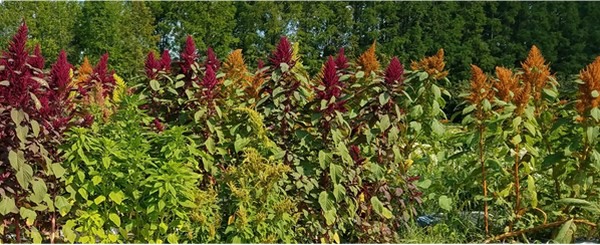Tropical spinach (Amaranthus spp.) is an important leafy vegetable in Africa and Asia, a minor grain crop in the United States, and a major grain crop in Latin America. The rich nutritional and health values of the leaf and grain as well as its potential as a complement to the regular spinach (“temperate spinach” Spinacia oleracea) during the hot summer months when the latter cannot be grown in the field in New Jersey (NJ), make tropical spinach an attractive vegetable option for the grower and consumer in NJ and the Mid-Atlantic. Also, the influx of ethnic nationalities from Africa, Asia, and Latin America into the Mid-Atlantic is an additional incentive for the grower to explore the growing market opportunities.
Between 2016 and 2018 studies were conducted in the greenhouse and field at Rutgers University, New Brunswick, NJ, to compare 22 tropical spinach selections (17 African/American types; 5 Asian types) sourced from the US and international seed markets for suitability for leaf and/or grain production. In the greenhouse tropical spinach was raised under 16/8 hr light/dark regime (high pressure sodium light), 75-85oF temperature and 75-85% relative humidity for 16 weeks. In the field, tropical spinach was either direct seeded or transplanted into a sandy loam soil (pH 6.5-6.8, 1.8-2.1% organic matter) using nursey raised seedlings. Field sowing or transplanting was done on raised seedbeds under black plastic mulch with drip irrigation to supplement natural rainfall. Both in the field and greenhouse, 20-20-20 NPK fertilizer was applied based on soil test results and recommendation for greenhouse potting mix.
Results showed that African/American tropical spinach selections were far more productive than the Asian tropical spinach for both leaf and grain (African/American: 40-50 tons foliage/acre; 1-5 tons seed/acre; Asian:15-20 tons foliage/acre; 0.2-0.3-ton seed/acre). Figure 1 shows the morphology and color of three representatives of the tropical spinach selections evaluated in this study. Photos were taken at 3 weeks after transplanting (WATP). Figure 2 shows full grown tropical spinach selections with flower heads close to the mature grain production stage.

Figure 1. Three representatives of the tropical spinach selections used for leaf production in Central New Jersey. Photos were taken three weeks after transplanting. (Photos by Albert Ayeni)
African/American tropical spinach selections were harvested three times for leaf between 4-10 WATP, while the Asian selections were harvested maximum two times before losing growth vigor. Leaf damage by Japanese beetle (Popillia japonica), cucumber beetle (Diabrotica undecimpunctata) and Colorado potato beetle (Leptinotarsa decemlineata) reduced leaf marketability after the first round of harvest in July. Damage was more severe in Asian tropical spinach selections, which significantly reduced growth vigor.

Table 1. Foliage color, marketable foliage, and wholesale market prices for African/American and Asian tropical spinach selections in Central New Jersey, 2018.
Among the 17 African/American and five Asian tropical spinach selections evaluated at the start of the study, eight African/American and three Asian tropical spinach selections were further evaluated for acceptance in Asian grocery stores and New Brunswick farmers markets. For leaf production among the African/American tropical spinach, selections #2, #3, #6, #8, #15 and #16 ranked higher than #5 and #14 (Table 1). Among the Asian selections the order for leaf production was Red Stripe >Asian Red >Southern Red. African/American red tropical spinach selections #2, #3, and #14 and the Asian selections Red stripe, Asian red and Southern red, commanded higher demand in the leaf market followed by the red/green or variegated African/American selections #6 and #16. The green African/American selections #5, #8 and #15 were the least patronized by customers, which were predominantly Asians. For grain production, the Asian selections performed poorly (0.2-0.3 tons/acre). Among the African/American selections, #6 and #14 were the least productive (1-2 tons/acre) while the others ranked about equally in grain production (4-5 tons/acre). Work is progressing on grain quality evaluation for popping and flour production.

Figure 2. Tropical spinach selections at the grain production stage in Central New Jersey, USA, 2018 (Photo by Albert Ayeni)
In sum, African/American tropical spinach selections and Asian selections adapt well to NJ growing conditions in the field from May to October. The African/American tropical spinach selections overall were more productive than the Asian selections for leaf. In general, the red and red/green (or variegated) tropical spinach selections were preferred to the green types in the Asian groceries and farmers markets in New Brunswick. Ethnic nationalities from Africa showed a strong preference for the green tropical spinach while the Caribbean nationalities seemed less selective in preference for the red, green and variegated. African/American tropical spinach selections were superior to Asian selections in grain production. Further studies will examine grain quality for taste and nutritional quality.
References:
Anonymous 2022. Growing Amaranth as a Food Plant (Amaranthus spp.) How to grow Amaranth, why, and what to do with it. Tropical Permaculture
Hoidal, N., Gallardo, M.D., Jacobsen, S-E., and Alandia, G. 2019. Amaranth as a Dual-Use Crop for Leafy Greens and Seeds: Stable Responses to Leaf Harvest Across Genotypes and Environments. Frontiers in Plant Science 2019
Kauffman, C.S., and Weber, L.E. 1990. Grain amaranth. p. 127-139. In: J. Janick and J.E. Simon (eds.), Advances in new crops. Timber Press, Portland, OR
Novak, S. 2018. 7 Reasons Amaranth Greens are the New Kale Prakash, D. and Pal, M. 1991 Nutritional and antinutritional composition of vegetable and grain Amaranth leaves. Journal of the Science of Food and Agriculture 4:573-583
Singh, B.P. and Whitehead, W.F. 1996. Management methods for producing vegetable amaranth. p. 511-515. In: J. Janick (ed.), Progress in new crops. ASHS Press, Arlington, VA.
Stallknecht, G.F. and J.R. Schulz-Schaeffer. 1993. Amaranth rediscovered. p. 211-218. In: J. Janick and J.E. Simon (eds.), New crops. Wiley, New York.
